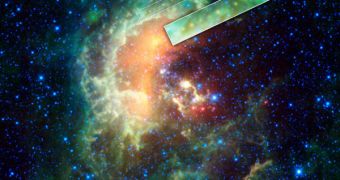It's no longer a secret to anyone that our solar system is filled to the brink with all sorts of space rocks, ranging from comets and asteroids to meteorites. These objects continuously fly around the Sun, getting shot either towards the inner solar system, or back on the fringes, way beyond the orbit of Pluto. In a fortuitous turn of events, the NASA Wide-Field Infrared Survey Explorer (WISE) telescope recently managed to snap a photo of such a space rock, the asteroid 1719 Jens, as it zoomed right in front of the Tadpole Nebula, a beautiful star-forming cloud a good distance away from Earth.
This particular stellar nursery is located about 12,000 light-years away from our planet, in the constellation Auriga. WISE was conducting routine investigations on the formation, as part of its all-sky survey. The telescope uses four extremely sensitive, liquid hydrogen-cooled infrared detectors to conduct its studies. As it was snapping photos of the Tadpole Nebula, the observatory also caught the asteroid as it was moving between it and its target, but within our solar system. If the space rock had been located further away, its light would have been drowned by that of the nebula. But the proximity to Earth and WISE ensured that it popped into view as experts received the images.
This particular stellar nursery got its name from the fact that it features two tadpole-like pillars, which have been designated Sim 129 and Sim 130. It produces massive new stars, some of which have up to ten times the mass of our Sun. What's interesting to note is that some of the fireballs in the nebula are as young as a million years, which makes them infants in cosmic time frames. They are only at the beginning of their life span, and they are continuously blasting the thick clouds of dust and gas around them with energetic ultraviolet radiation, Space reports.
WISE is one of NASA's newest satellites. Launched in December 2009, the telescope will remain in orbit for ten months, during which time it will perform one-and-a-half full-sky surveys. The studies will be conducted in four infrared wavelengths. Ned Wright, the principal investigator of the mission, proposed some time ago that the time line for the observatory be extended, but a panel recently found that the scientific return would not justify the costs. Wright is based at the University of California in Los Angeles (UCLA). The WISE mission is managed by experts at the NASA Jet Propulsion Laboratory (JPL), in Pasadena, California.

 14 DAY TRIAL //
14 DAY TRIAL //